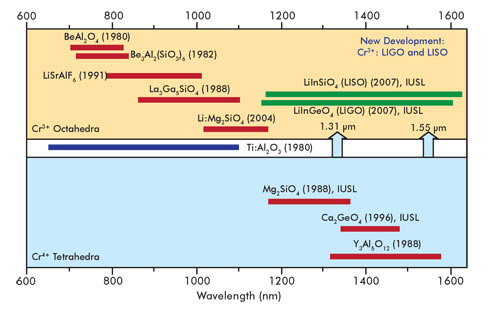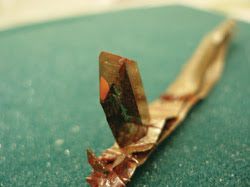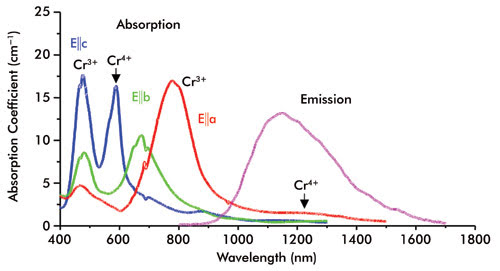Trivalent chromium-doped LIGO/LISO offers the widest lasing bandwidth in the telecommunications windows.
Mikhail Sharonov, Alexey Bykov and Robert R. Alfano Institute for Ultrafast Spectroscopy and Lasers, City College of The City University of New York
Newly developed Cr3+ laser crystals called LIGO and LISO, developed at the Institute for Ultrafast Spectroscopy and Lasers (IUSL) at City College of the City University of New York, extend the family of ruby and alexandrite lasers operating in the near-infrared from 1150 to 1620 nm for possible 6-fs-pulse-generation and telecommunications applications.
Combined with Ti:sapphire crystals, pulses as short as approximately 2 fs could be produced. In addition, the broad spectral operation of these materials is suitable for generating 6-fs-pulse optical coherence tomography, condensed matter physics, and biological and chemical time-resolved applications. Using supercontinuum generation and pulse compression could result even in the attosecond regime.
The 470-nm range of operation of LIGO and LISO slightly surpasses the “king” of broadband lasers – the Ti:sapphire (650 to 1100 nm) – and perfectly complements its range in the near-infrared.
Trivalent chromium laser operation was first demonstrated with the ruby (Cr3+:Al2O3) laser by T.H. Maiman in 1960. The ruby operates at a fixed and narrow wavelength of 694.3 nm. In 1963, a broadband tunable laser was demonstrated in Ni2+:CaF2 at cryogenic temperatures by Johnson et al. Several other transition metal-doped crystal lasers operating at low temperatures followed in the mid-1960s but did not attract much interest because of the necessity for cryogenic cooling. The development of broadband lasers eventually shifted from doped crystals to dyes and color-center laser media in the 1970s and 1980s.
Research on transition metal-doped tunable lasers exploded in 1980 after Walling et al demonstrated tunable lasers operating in the 700- to 820-nm range at room temperature in trivalent chromium-doped Cr3+:BeAl2O4 (alexandrite) crystals (Figure 1). Since then, hundreds of Cr3+-doped crystals have been studied and tens of Cr3+-doped laser crystals have been developed operating in the deep red.

Figure 1. Shown is the range of tunability of some chromium-doped lasers. Trivalent chromium centers in octahedral sites are shown at the top, and tetravalent chromium centers in tetrahedral sites at the bottom. Distortion of octahedral sites moves lasing in novel Cr3+:LIGO and Cr3+:LISO crystals into the indispensable range for numerous applications, the near-infrared range of the spectrum being at the same time the widest of both trivalent and tetravalent chromium lasers. The range of the Ti:sapphire laser is shown in dark blue. Major telecommunication windows at 1.31 and 1.55 μm are depicted by gray arrows.
Cr3+ occupies octahedral sites – oxygen ions – in the crystal lattice. The range of tunability of trivalent chromium-doped crystals previously did not extend beyond 1.1 µm because of the relatively strong crystal field of octahedral sites.
Early advances
Near-infrared room-temperature tunable laser operation spanning 1150 to 1300 nm was obtained in chromium-doped Mg2SiO4 (forsterite) crystals in 1989 at IUSL. In forsterite crystals, chromium is in the tetravalent state, Cr4+, and occupies tetrahedral sites of the lattice. Tetrahedral sites have almost twice the lower crystal field compared with octahedral sites, resulting in less energy-level splitting and in the spectrum of fluorescence shifted toward longer wavelengths.
Tetravalent-doped forsterite has an 1170- to 1370-nm range of tunability. Since 1989, several other Cr4+ laser materials have been developed around the world.
The salient feature of the first tunable tri- and tetravalent chromium-doped Cr3+:BeAl2O4 and Cr4+:Mg2SiO4 (forsterite) lasers is that they belong to the same olivine crystal structure. In this structure, there are octahedral and tetragonal sites. Their occupancy by tri- or tetravalent chromium, respectively, depends on chemical composition of the crystals and on growing conditions.
In forsterite, both trivalent and tetravalent chromium can be presented; the active centers are tetravalent chromium in tetrahedral sites, while trivalent chromium is harmful because it reduces efficiency of laser operation. Many efforts were made to suppress entering the trivalent chromium into forsterite lattice. In 1989, a new Cr4+-doped crystal, Ca2GeO4 (cunyite), was developed by IUSL in which only tetravalent chromium centers are presented; the formation of trivalent octahedral centers is prohibited by Ca/Cr ionic radii mismatch.
In 2005, also at IUSL, the commonly accepted 25-year rule that trivalent chromium is for the range shorter than 1 µm and tetravalent chromium, for the 1- to 1.6-µm range, was broken. Researchers found that, in novel chromium-doped LiInGeO4 (LIGO) (Figure 2), LiScGeO4 and LiInSiO4 (LISO) crystals – with the same faithful olivine structure – the ion responsible for near-infrared fluorescence in the 900- to 1800-nm range – typical for tetravalent chromium in tetrahedral sites – is actually trivalent chromium in distorted octahedral sites.

Figure 2. This Cr:LiInGeO4 single crystal (20 × 7 × 4 mm) was grown spontaneously from flux.
This is possible because of the strong distortion of octahedral sites. The distortion leads to weaker Coulomb repulsion between d-electrons of dopant and oxygen ligands and, therefore, to significantly lower splitting of energy levels compared with undistorted octahedra. A unique combination of a low symmetry crystal field, a strong Stokes shift and relatively low nonradiative quenching made possible room-temperature laser operation in the 1.1- to 1.6-µm range with a width of 470 nm.
Small modifications
In the olivine structure, substitution of both octahedral and tetrahedral sites by tri- and tetravalent chromium is possible, respectively. Absorption of both is seen in the absorption spectra (Figure 3), but in contrast to similar Mg2SiO4 (forsterite) and Ca2GeO4 (cunyite) crystals, emission of tetravalent chromium is totally quenched. Small modification of the olivine structure caused by Li-In or Li-Sc pair the replacement of Mg or Ca in Mg2SiO4 (forsterite), and Ca2GeO4 (cunyite) crystals render optical behavior of these crystals drastically different; in some, opposite to forsterite and cunyite. Emission from trivalent chromium is strong and emission of tetravalent chromium is quenched, in contrast to forsterite tetravalent chromium centers, which should be suppressed because they reduce efficiency of lasing.

Figure 3. In this view of the polarized absorption and emission spectra of Cr:LiInGeO4, both trivalent and tetravalent chromium absorption are visible. Bands assigned to absorption of tetravalent chromium in tetrahedral sites are marked with arrows. There is no emission on excitation into Cr4+ absorption bands; broadband emission from 900 to 1700 nm is attributed to Cr3+ centers. Absorption of tetravalent chromium in the range of emission results in lower efficiency of the laser operation.
Many of the uncommon properties of these novel crystals – LIGO, LISO – are yet to be understood, but it is clear that novel trivalent chromium-doped crystals are very promising media for applications in the near-infrared range.
This research was supported by the US Department of Defense, the National Science Foundation, NASA and the Organized Research Program at CCNY of CUNY.
Meet the authors
Mikhail Sharonov and Alexey Bykov are senior researchers at the City College of New York; e-mail: [email protected]; [email protected]. Robert R. Alfano is distinguished professor of physics at the City College of New York and director of the Institute of Ultrafast Spectroscopy and Lasers; e-mail: [email protected].